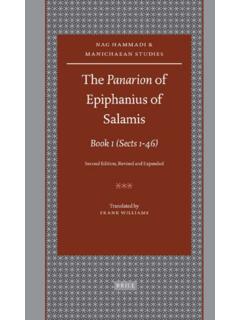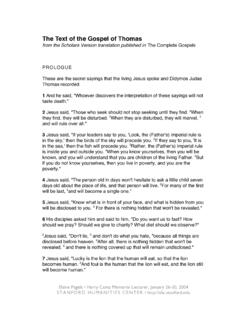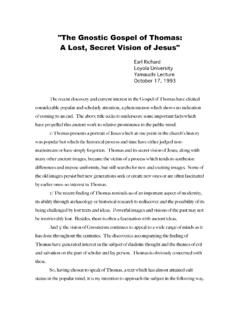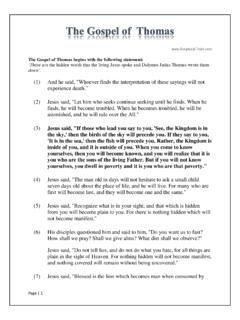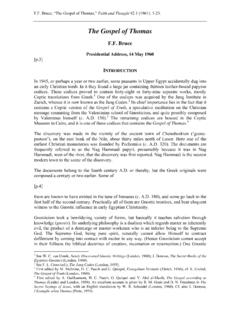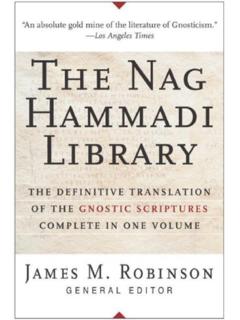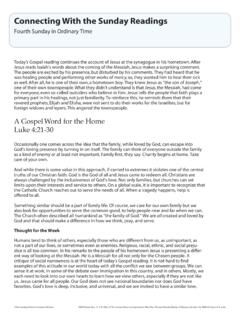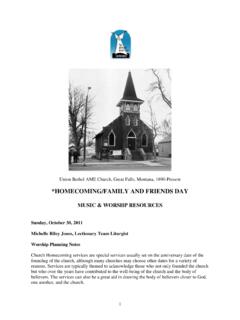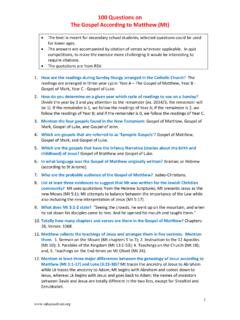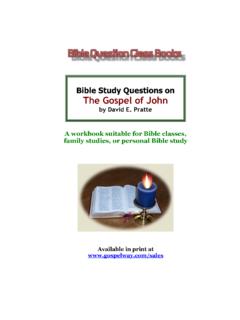Transcription of The Secret Teachings of Jesus - gnosis.study
1 123 FIRST VINTAGE BOOKS EDITION, June 1986 Copyright 1984 by Marvin W. MeyerAll rights reserved under International and Pan-American Copyright in the United States by Random House, Inc., New York, andsimultaneously in Canada by Random House of Canada Limited, published, in hardcover, by Random House, Inc. in of Congress Cataloging-in-Publication DataNag Hammadi codices. English. Selections. The Secret Teachings of Jesus . Reprint. Originally published in hardcover byRandom House, Inc. in 1984. 1. Gnosticism. 2. Jesus Christ Teachings . I. Meyer,Marvin W. II. 1986 229 .8052 85-40864eISBN: Stephen and Jonathan5 gospel of thomas saying 26 AcknowledgmentsI would like to express my appreciation to several people whohave assisted in the preparation of this book. The Institute forAntiquity and Christianity of Claremont Graduate School, and theInstitute s director, James M. Robinson, provided a supportivecontext for my study of the Nag Hammadi texts translated andinterpreted here.
2 The availability of the photographic andbibliographical resources in the Institute s Nag Hammadi archivegreatly aided my translational work. I have discussed portions ofthe translations commonly the most di cult and perplexingpassages with students and colleagues, especially in theClaremont Coptic texts seminar, and to these friends I extend mythanks. Elaine H. Pagels, James M. Robinson, and Richard Smithhave seen the entirety of the manuscript in an earlier draft, andtheir comments have proved particularly also wish to acknowledge the painstaking editorial work ofBeverly Haviland and Laura Schultz at Random House, and theskillful word-processing of Deborah De , I o er my most profound expression of gratitude to mywife and children, whose loving encouragement and patiencehave been indispensable for the completion of this W. Meyer Ferrum College, Virginia7 ContentsCoverOther Books by This AuthorTitle PageCopyrightDedicationEpigraphAcknowled gmentsIntroductionThe Secret Book of JamesThe gospel of ThomasThe Book of ThomasThe Secret Book of JohnNotesBibliographyAbout the Translator8 IntroductionIn December 1945, two Egyptian fellahin were riding theircamels, searching for natural fertilizer along the base of themagni cent cli s that grace the Nile River as it ows around thegreat river bend in Upper Egypt.
3 As one of these farmers,Muhammad Ali al-Samman Muhammad Khalifah, tells the story,they hobbled their camels and began to dig near a large boulderthat lies at the foot of an exceptionally impressive cli called theJabal al-Tarif. Suddenly they struck something hard. They dugfarther and unearthed a sealed storage jar that had lain there inthe sand of Egypt for hundreds of years. At rst Muhammad Alifeared to open the jar, lest he release a jinn, or spirit, imprisonedinside. Then he wondered whether the jar might not contain gold,just as other containers discovered a few kilometers upstream atthe Valley of the Kings had yielded gold and treasures. His love ofgold overcame his fear of jinns, and he did break open the to Muhammad Ali, indeed there was gold inside: it ew out of the jar and ascended to the sky, leaving only acollection of old papyrus books for him to throw onto his cameland take gold that Muhammad Ali saw was probably tiny papyrusfragments.
4 Bits of papyrus, golden in color and glistening in thesun, could easily be mistaken for ecks of gold by one who hopedto nd treasure. As disappointed as he might have been that day,Muhammad Ali found a real treasure, more valuable, perhaps,than a jar full of gold: a collection of ancient manuscripts, nowcalled the Nag Hammadi library. This manuscript discoveryconsists of thirteen codices, or books, containing some fty-twotexts, the majority of which were previously unknown. Most ofthe texts re ect a mystical, esoteric religious movement that weterm Gnosticism, from the Greek word gnosis, knowledge. Thesetexts are also, with a few exceptions, Christian documents, andthus they provide us with valuable new information about the9character of the early church, and the Gnostic Christians withinthe church, during its rst, formative Nag Hammadi manuscripts are giving us an increasinglyclear perception of the Gnostic movement. Gnostics emphasizedthe quest for understanding, but not a common, mundaneunderstanding; they searched for a higher knowledge, a moreprofound insight into the deep and Secret things of God.
5 Likeother mystics, Gnostics admitted that this saving knowledgecannot be acquired through the memorization of phrases or thestudy of books; nevertheless, like other mystics, they composednumerous documents explaining the nature of spiritual Gnostic texts proclaim a completely good and transcendentGod, whose enlightened greatness is utterly unfathomable andessentially indescribable. Yet this divine Other can beexperienced in a person s inner life, for the spirit within isactually the divine self, the inner spark or ray of heavenly tragedy of human existence, however, is that most people failto realize the ful llment of the divine life, because of the harshworld that functions as the stage for the human drama. TheGnostics understood this mortal world, with all its evils anddistractions, to be a deadly trap for one who seeks , the divine spirit is imprisoned by the passions of thesensual soul and the elements of the eshly body.
6 Gnostic textsemploy various gures of speech to depict the sorry fate of theentrapped spirit: it is asleep, drunk, sick, ignorant, and indarkness. In order to be liberated, then, the spirit needs to beawakened and brought to sobriety, wholeness, knowledge, andenlightenment. This transformation in one s life, Gnosticsmaintained, is accomplished through a call from God the Godwithout and within to discover true knowledge and rest. ForGnostic Christians, the source of the divine call is can see why many Gnostics were considered dissidents inthe ancient world. They called into question the values of civilized society and instead fostered spiritual values andlifestyles. Some radical Gnostics apparently retreated from theworld to the solitary life of the monk or the ascetic, and refusedto participate in the everyday business of human society. Otherequally radical Gnostics seem to have aunted their disdain for10conventional human values by disregarding the amenities ofpolite society and practicing a libertine way of life.
7 Most Gnostics,however, probably led normal lives in society, while engaging inan inner, spiritual quest for God. Within the church, too, Gnosticbelievers often advocated a faith and life quite di erent fromwhat church leaders were promoting. Gnostic Christianschallenged the authority of the priests and bishops and suggestedthat a spiritual, Gnostic life devoted to a spiritual, Gnostic Christallowed them to approach and embrace God directly. For theirstance Gnostic Christians were eventually condemned as hereticsin the debates about orthodoxy and heresy that raged within theearly church, and most of their books were suppressed ordestroyed by their triumphant , before the discovery of the Nag Hammadimanuscripts, we possessed relatively few reliable sources ofinformation on the Gnostics. Much of our information came fromthe hostile writings of the philosophers and theologians who triedto silence the Gnostics. Now the Nag Hammadi texts nally allowthe Gnostics to speak for themselves and present their faith andtheology in a fair and attractive of the most spectacular documents from the NagHammadi library are published in the present volume: the SecretBook of James, the gospel of thomas , the Book of thomas , and theSecret Book of John.
8 Of the four, two (the gospel of thomas andthe Secret Book of John) are classics of Gnostic spirituality, knownalso from other manuscripts or fragments of manuscripts. All fourof the works are described, in the title or the opening of the text,as Secret Teachings of the Savior, and reliable followers of Jesus (his brother James; Judas thomas , regarded by some sources asJesus twin brother; or the spiritual disciple, John) serve asguarantors of the Secret traditions. Although the precise dating ofancient documents is notoriously di cult, all four of these textsseem to have been written around the second century , theSecret Book of James and the gospel of thomas probably beingearlier than the Book of thomas and the Secret Book of John. Allfour preserve older materials, and some of the recorded sayings ofthe Savior may go back to the historical Secret Book of James, the gospel of thomas , and the Book ofThomas consist of material that was collected and edited as a partof the early church s process of working and reworking sayings ofJesus.
9 We can see this process already in the New Testamentgospels. Matthew and Luke most likely composed their gospelsabout fteen to twenty years after Mark and used as their sourcesnot only the gospel of Mark but also a collection of Jesus sayings. Usually referred to simply as Q (from Quelle, German for source ), this collection of sayings does not exist independentlyas a text, but it may be reconstructed by means of a careful studyof Matthew and Luke. When this is done, it becomes clear that Qwas not a narrative gospel like Mark but rather a series of sayingsof Jesus strung together with little or no Q presented Jesus as a proclaimer of wise sayings, then theGospel of thomas is a document similar to Q in form and Q, the gospel of thomas is a substantial collection of Jesus sayings, with one saying immediately following another. In themajority of cases the only introduction to a saying is the stylizedquotation formula Jesus said. Yet, while it closely resembles Q,the gospel of thomas has been edited and revised by Christianswith gnosticizing interests.
10 It is explicitly a collection of secretsayings communicating Secret wisdom, and the properinterpretation of these sayings is said to unlock the mystery of lifeand death (see saying 1). The gospel of thomas thus includes notonly many sayings that call to mind New Testament teachingsattributed to Jesus , but also others that illustrate morespeci cally Gnostic themes (see sayings 22, 50, 75, 113).Already in the gospel of thomas (for example, sayings 12, 13,22, 61, 72, 73, 77) some limited narrative framework is added toa few of the sayings, and little dialogues between Jesus and hisfollowers are constructed. This tendency becomes more explicit inthe Secret Book of James and the Book of thomas . In these texts,sayings of Jesus are presented within more expansive discoursesof Jesus (reminiscent of those in the gospel of John), and thediscourses themselves are interrupted by statements and queriesof James, Peter, or Judas thomas . The Secret Book of Jamesemphasizes the place of James the Just, the brother of Jesus andhero of early Jewish Christians, and has James usurp the12dominant role reserved for Peter in New Testament traditions (seesuch passages as 1:2; 3:1 2, 12; 5:1).
